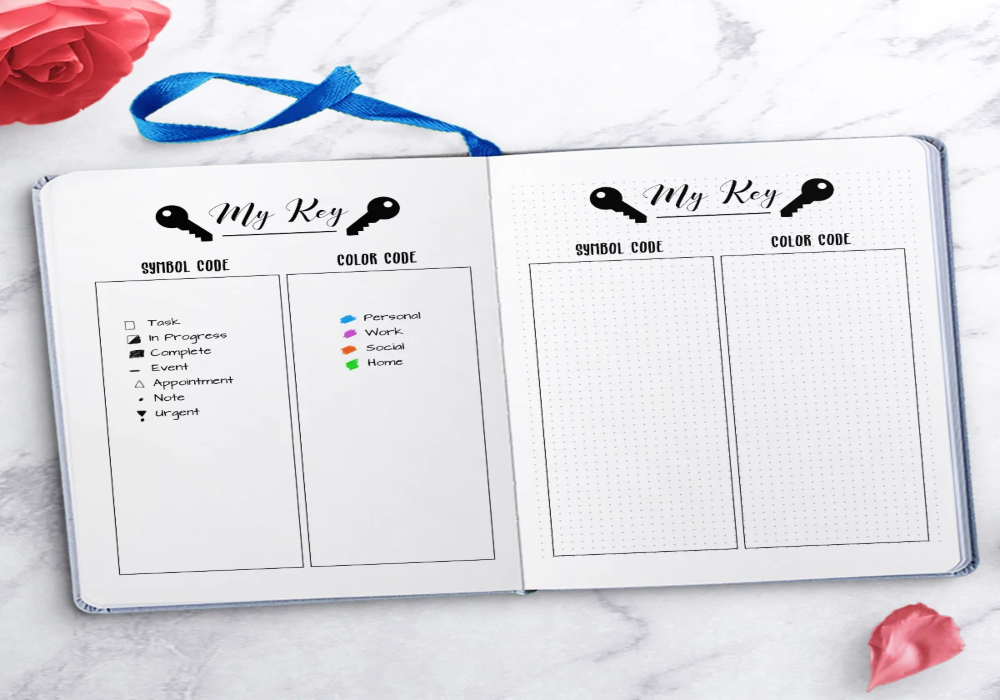Budgeting can be a challenging task, and many people struggle to keep track of their expenses and savings. However, there is a simple and effective solution that can help you manage your finances: a bullet journal. A bullet journal is an analog system that can be used to track your personal finances, including your income, expenses, and savings. In this blog post, I will share with you how to start a budget journal and provide you with ideas to help you get started.
Bullet journals are highly customizable, and there are countless budget journal ideas that you can use to create a system that works for you. For example, you can create a monthly budget page that outlines your income and expenses for the month, or a savings tracker that helps you monitor your progress towards your financial goals. You can also use different symbols and colors to categorize your expenses and income, making it easier to see where your money is going.
A bullet journal can be a powerful tool for money management, providing a simple and effective way to track your finances and stay on top of your budget. Whether you’re new to budgeting or looking for a more effective way to manage your money, a bullet journal can help you take control of your finances and achieve your financial goals.
Setting Up Your Budget Journal
Keeping track of your finances is an essential part of managing your money. A budget journal can be a great tool to help you stay organized and on top of your finances. In this section, we’ll go over some tips for setting up your budget journal.
Choosing the Right Bullet Journal
The first step to setting up your budget journal is choosing the right bullet journal. A dotted journal notebook is a popular choice for bullet journaling, as it provides a customizable layout that allows for easy organization and tracking. When choosing a journal, consider the size, paper quality, and binding type that will work best for your needs.
Essential Bullet Journal Budget Spreads
Once you have your journal, it’s time to start setting up your budget spreads. Essential spreads include a monthly budget tracker, a spending tracker, a monthly bills tracker, and a financial goals spread. These spreads will help you track your income, expenses, and progress towards your financial goals.
Budget Tracker Ideas and Customization
Customization is key when it comes to bullet journaling, and your budget journal is no exception. There are a variety of budget tracker ideas that you can use to customize your journal to fit your specific needs. For example, you may want to include a credit card debt reduction tracker or a debt tracker to help you stay on top of your debt repayment goals. You can use different colors, fonts, and symbols to make your spreads visually appealing and easy to read.
Setting up a budget journal can be a great way to stay organized and on top of your finances. By choosing the right bullet journal, setting up essential budget spreads, and customizing your journal to fit your needs, you can create a budget journal that works for you.
Tracking Finances with Your Bullet Journal
Keeping track of your finances is essential for achieving your savings goals, paying off debt, and managing your budget. A bullet journal can be a valuable tool for tracking your finances. Here are some ideas for creating effective financial trackers in your bullet journal.
Monthly and Weekly Budget Trackers
One of the most popular ways to track your finances in a bullet journal is by creating a monthly or weekly budget tracker. This can help you monitor your spending and ensure that you stay within your budget.
To create a budget tracker, you can use a simple table or chart to list your income and expenses. Be sure to include all of your regular bills, such as rent/mortgage, utilities, and groceries. You can also add a section for discretionary spending, such as entertainment or eating out.
Expense and Savings Trackers
An expense tracker is another useful tool for monitoring your finances. This can help you identify areas where you may be overspending and find ways to cut back. To create an expense tracker, you can use a table or chart to list your monthly expenses and track your spending. You can also add a section for savings goals, such as an emergency fund or vacation fund.
Income, Bills, and Debt Trackers
Tracking your income, bills, and debt can also be helpful for managing your finances. You can create a tracker to monitor your income and ensure that you are meeting your financial goals. You can also create a bill tracker to keep track of your monthly bills and ensure that you pay them on time. A debt tracker can help you monitor your progress in paying off debt and staying on track with your financial goals.
A bullet journal can be an effective tool for tracking your finances and achieving your financial goals. By creating monthly and weekly budget trackers, expense and savings trackers, and income, bills, and debt trackers, you can gain greater control over your finances and achieve financial success.

Analyzing Spending Habits and Financial Goals
Managing finances can be a challenging task, but keeping track of spending habits and financial goals can help individuals achieve financial stability. By analyzing spending habits and setting financial goals, one can create a budget that aligns with their priorities and helps in achieving their financial objectives.
Identifying and Addressing Bad Spending Habits
Identifying bad spending habits is the first step towards creating a budget that works. Individuals need to be aware of their spending patterns and identify areas where they tend to overspend. This can be achieved by analyzing bank statements, credit card bills, and receipts. Once bad spending habits are identified, it is important to address them to avoid overspending.
One way to address bad spending habits is by creating a priority-based budget. This involves listing expenses in order of priority and allocating funds accordingly. Another method is the zero-based budget, which involves allocating every dollar to a specific expense. Both methods can help individuals avoid overspending and prioritize their spending.
Setting and Tracking Financial Goals
Setting financial goals is an important step towards achieving financial stability. Individuals need to identify their short-term and long-term financial goals and create a plan to achieve them. This can include setting savings goals, paying off debt, or investing in retirement accounts.
Tracking financial goals is equally important as setting them. This can be achieved by using financial spreadsheets or budgeting apps. By tracking progress towards financial goals, individuals can make necessary adjustments to their budget and ensure they are on track to achieve their objectives.
Analyzing spending habits and setting financial goals is crucial to achieving financial stability. By identifying bad spending habits and setting priorities, individuals can create a budget that aligns with their financial goals. Tracking progress towards financial goals can help individuals make necessary adjustments to their budget and ensure they are on track to achieve their objectives.
Digital and Alternative Budgeting Tools
Bullet journaling is a great way to track your finances, but it’s not the only option. There are many digital and alternative budgeting tools available that can help you stay on top of your finances. In this section, we’ll explore some of these tools and how they can be used in conjunction with bullet journaling.
Budgeting Apps and Software
There are many budgeting apps and software available that can help you track your expenses, set budgets, and manage your money. Some popular options include Mint, YNAB (You Need A Budget), and Personal Capital. These apps can be a great way to keep track of your finances on the go, and many of them offer features like bill reminders and investment tracking.
If you prefer to use a spreadsheet to track your finances, there are many templates available online that can help you get started. Google Sheets and Microsoft Excel both offer templates for budgeting and expense tracking, and there are many third-party templates available as well.
Integrating Bullet Journaling with Digital Tools
If you prefer to use a bullet journal to track your finances, but also want to take advantage of the convenience of digital tools, there are many ways to integrate the two. For example, you could use a budgeting app to track your expenses, and then transfer that information to your bullet journal at the end of the month.
Another option is to use a bullet journaling app, such as GoodNotes or Notability, to create digital versions of your bullet journal spreads. This can be a great way to keep your bullet journal with you at all times, without having to carry a physical notebook.
There are many digital and alternative budgeting tools available that can help you stay on top of your finances. Whether you prefer to use a spreadsheet, a budgeting app, or a combination of both, there is a tool out there that can help you achieve your financial goals.
Frequently Asked Questions
What essential elements should be present in a budget journal?
A budget journal should contain essential elements such as a monthly budget tracker, a savings tracker, an expense tracker, and a debt tracker. These elements help to keep track of one’s finances and ensure that one stays within their budget.
How can one effectively create and maintain a budget diary?
Creating a budget diary involves setting financial goals, creating a budget, and tracking expenses. To maintain a budget diary, one should make it a habit to regularly track expenses, review their budget, and adjust it accordingly.
What are some simple yet effective budget journal layouts?
Simple budget journal layouts include a basic expense tracker, a monthly budget tracker, and a savings tracker. These layouts can be customized to fit one’s specific needs and preferences.
Can you provide tips for tracking expenses within a bullet journal?
To track expenses within a bullet journal, one should create a designated page for expenses and categorize them accordingly. It is also helpful to regularly review and update the expense tracker to ensure accuracy.
What templates work best for a monthly budget in a bullet journal?
Templates that work best for a monthly budget in a bullet journal include a monthly budget tracker, a savings tracker, and an expense tracker. These templates can be customized to fit one’s specific needs and preferences.
How can I integrate a financial tracker into my journaling routine?
To integrate a financial tracker into a journaling routine, one should make it a habit to regularly update and review their budget diary. It is also helpful to set financial goals and track progress towards those goals.



